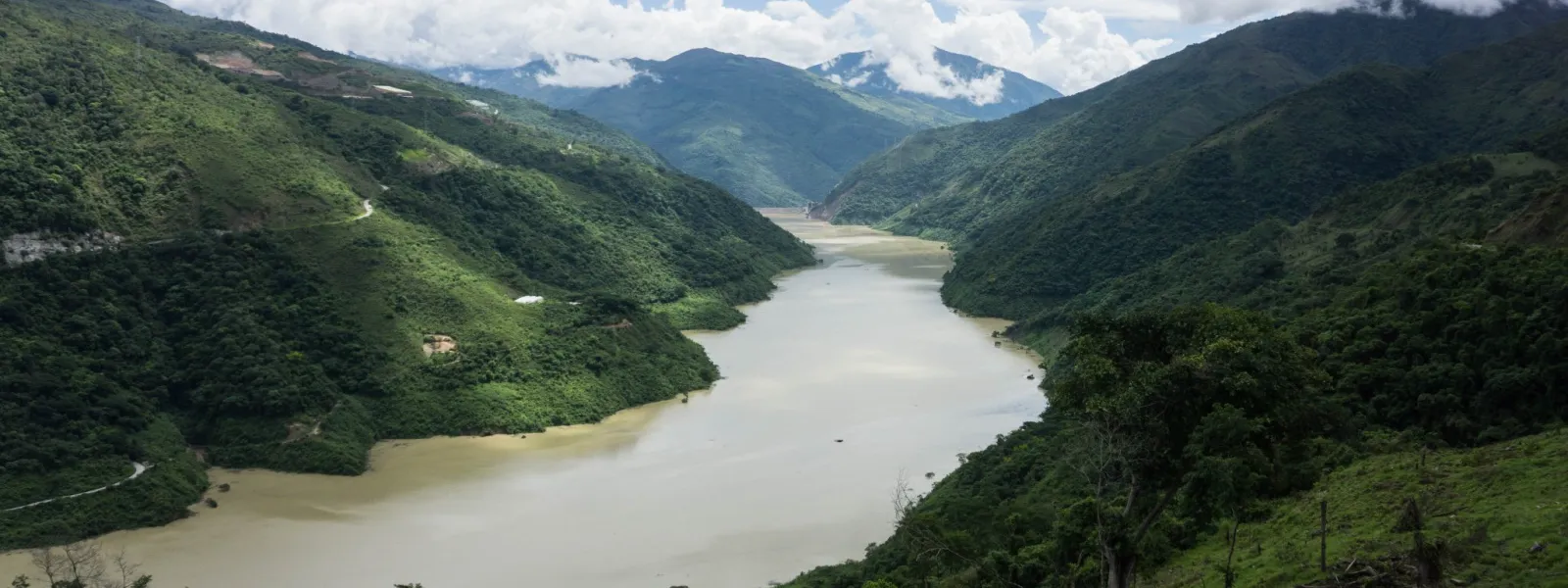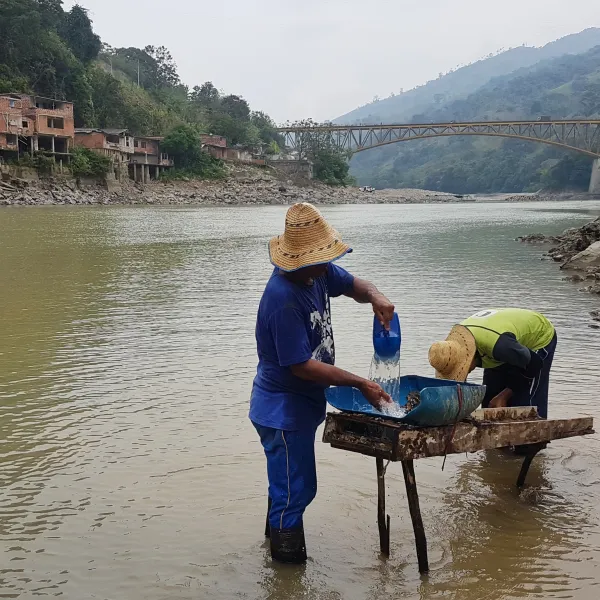
Project
Bram EbusSeeking justice for communities affected by the Hidroituango dam
The Cauca River is the second largest in Colombia. Many of the communities settled throughout its expansive watershed depend on the river for their livelihood, includingd fishing and agriculture.
Winding its way through the Andes mountains, the river courses through seven departments of Colombia, including Antioquia, now home to the Hidroituango Dam—a project that has created an unprecedented humanitarian crisis.
In May of 2018, an error in the dam’s construction caused floods, landslides, avalanches, and the evacuation of more than 25 thousand people. This tragedy exposed the inadequate evaluation of the project’s environmental impacts and the lack of environmental regulation in the dam’s authorization processes.
The project has led to systematic human rights violations, including the disproportionate use of force and an increase in violence against affected communities, who are represented by the Ríos Vivos (“Living Rivers”) Movement of Colombia.
Though construction is not complete, and electricity has not yet been generated, the dam has flooded more than 4,500 hectares of vegetation, releasing a significant amount of methane—a greenhouse gas that aggravates the global climate crisis.
And despite its inadequate implementation, IDB Invest, a private branch of the Inter-American Development Bank, invested millions of dollars into the hydroelectric project and facilitated the investment of billions more from other international banks.
Communities affected by Hidroituango have spent decades denouncing the serious problems caused by the dam, and will not waver in their struggle to defend their land and water.
Partners:

Related projects
Colombian Constitutional Court Admits AIDA's Complaint Against Mining Code (Spanish Text Only)
CORTE CONSTITUCIONAL ADMITE NUEVA DEMANDA CONTRA CÓDIGO DE MINAS PARA DEFENDER EL PRINCIPIO DE PRECAUCIÓN FRENTE A LAS ACTIVIDADES MINERAS PARA PUBLICACIÓN INMEDIATA CONTACTOS: Jerónimo Rodríguez, AIDA, Tel. (571) 2681804 Andrés Idarraga, CENSAT, Tel. (571) 2440581 [email protected] [email protected] BOGOTÁ, 20 de mayo de 2009.- La Corte Constitucional colombiana admitió esta semana la acción de inconstitucionalidad presentada por la Asociación Interamericana para la Defensa del Ambiente (AIDA), CENSAT – Agua Viva, el Observatorio de Conflictos Ambientales de la Universidad de Caldas y la Corporación Gestión por los Intereses Ambientales y Públicos (Iniciativa GESAP) contra los artículos 203 y 213 del Código de Minas, que permiten el uso de los recursos naturales para la exploración minera sin licencia ambiental y limitan las causales por las que las autoridades ambientales pueden negar una licencia ambiental para actividades mineras. Los artículos del Código de Minas demandados violan la Constitución de Colombia y la legislación ambiental internacional. Estos artículos priorizan la actividad minera sobre la protección ambiental, al punto de limitar las capacidades de las propias autoridades para verificar las condiciones de la explotación, y eventualmente autorizar la exploración y explotación con condiciones que sean ambientalmente sostenibles. Por esto, se violan entre otros, los principios de desarrollo sostenible y el principio de precaución que son parte fundamental de nuestra legislación. “Reconocemos que la minería es una industria importante para nuestro país, pero también lo es la protección de los recursos naturales, que garantizan la existencia misma de la especie humana en la actualidad y en el futuro. Por esto solicitamos a la Corte que aplique el principio de desarrollo sostenible reconocido en nuestra Constitución para que la minería se implemente sin la generación de daños severos e irreversibles a zonas estratégicas, como los páramos, y de las que dependen muchas comunidades”, señaló Jerónimo Rodríguez, asesor legal de AIDA en Colombia. Esta demanda se une a la presentada por AIDA y otros contra el artículo 34 del Código de Minas, que está pendiente de sentencia por la Corte Constitucional Colombiana. Ambas demandas recogen e insisten sobre las preocupaciones del Ministerio de Ambiente y de la Procuraduría General de la Nación frente a los efectos de las actividades mineras en el ambiente y la necesidad imperiosa de control, sin debilitar aún más las normas. “Buscamos con esta demanda de inconstitucionalidad la efectiva protección al ambiente y que el uso ocasional o transitorio de los recursos naturales en las actividades de exploración deba evaluarse por las autoridades ambientales. Además que las licencias ambientales no estén limitadas por causales formales, sino que las autoridades ambientales puedan, cuando sea necesario para protección ambiental y del interés público, negar licencias para la minería en aplicación del principio de precaución y de normas ambientales aplicables”, concluyó Rodríguez. AIDA es una ONG legal ambiental hemisférica que trabaja para fortalecer la capacidad de las personas para garantizar su derecho individual y colectivo a un ambiente sano por medio del desarrollo, aplicación y cumplimiento efectivo de la legislación nacional e internacional. Entre otros temas, AIDA prioriza la protección del derecho al agua y asegurar recursos de agua dulce adecuados para las comunidades y los ecosistemas.
Read moreCosta Rican Court Orders Expropriation Of Land Slated For Tourism Development In The Leatherback Marine National Park
For immediate release: May 14, 2008 Press contacts: Rolando Castro, Attorney, CEDARENA Gladys Martínez, Attorney, AIDA (506) 2837080, [email protected] (506) 2837080, [email protected] COSTA RICAN COURT ORDERS EXPROPRIATION OF LAND SLATED FOR TOURISM DEVELOPMENT IN THE LEATHERBACK MARINE NATIONAL PARK SAN JOSÉ— On May 5th, the Constitutional Chamber of the Supreme Court of Justice of Costa Rica ordered the Ministry of Environment and Energy (MINAE) to begin expropriating private lands slated for tourism development within the Leatherback Marine National Park (LMNP) in Guanacaste. This decision follows a lawsuit filed in March 2005 by AIDA and its participating organizations in Costa Rica, the Center for Environmental Law and Natural Resources (CEDARENA), and Justice for Nature (JPN). The complaint alleged that the National Environmental Technical Secretary (SETENA), the Municipality of Santa Cruz, the Ministry of Finance, and MINAE violated the constitutional right to a healthy and ecologically balanced environment by not protecting the LMNP and the nesting sites of the leatherback turtle located therein. This is a very important precedent in Costa Rica and the hemisphere, given that tourism development is proceeding at an unprecedented pace throughout the Americas. The Municipality of Santa Cruz and SETENA had issued construction permits within the park, ignoring the impacts that tourism development would have upon the leatherback turtles. With this decision, these permits are now invalid. “We hope that the Municipality and SETENA have received a clear message that they must take extreme caution with regard to national parks, and not approve projects that endanger what the parks were created to protect,” stated Rolando Castro, an attorney for CEDARENA. “Construction and operation of tourist sites within the LMNP would aggravate existing threats to the beach,” he added. Leatherback turtles are animals from the Jurassic age that have been declared an endangered species on the international level. They require particular nesting conditions that can be easily disturbed by the presence of human beings and construction lights. Hence, the development of tourist sites can severely affect the turtles’ reproduction, and consequently, their survival. The Leatherback Marine National Park has become the most important nesting site for this species in the Western Pacific Ocean. “MINAE should immediately heed this order to prevent the destruction that has occurred at other Costa Rican nesting beaches, such as Flamingo and Tamarindo,” affirmed Gladys Martinez, AIDA attorney. “All authorities within the Costa Rican government have an obligation to protect this species, which is part of our common patrimony, in addition to being a tourist attraction and hence a valuable economic resource for the country,” she added.
Read moreConstitutional Court Orders Change in Environmental License for Baba Dam, Ecuador
CONSTITUTIONAL COURT ORDERS CHANGE IN ENVIRONMENTAL LICENSE FOR BABA DAM, ECUADOR FOR IMMEDIATE PUBLICATION: CONTACTS: Silvana Rivadeneira (593 3) 2 459822 Astrid Puentes, AIDA (5255) 5212-0141 [email protected] [email protected] Quito, January 8, 2009 - The Constitutional Court of Ecuador ordered the country's Ministry of Environment to review and reformulate the environmental authorization granted to Baba's Multi-purpose Project (PMB), and the Attorney-General to audit the procedures and the approval of the environmental impact evaluations. According to the court's decision, there are risks of severe, irreparable damage to the Ecuatorian biodiversity that weren't properly assessed, in accordance with the conclusions of the Inter-American Development Bank experts. This resolution from Ecuador's highest court is a consequence of the lawsuit promoted by ECOLEX in May, 2007, which was rejected by the initial judge. ECOLEX then appealed to the Constitutional Court, insisting that it consisted in a violation of the human rights to a safe environment, to water, to property, to work, and to food, among others. Last June AIDA and the international organizations International Rivers and FIAN International supported the appeal through an amicus curiae document, denouncing the violations to international environmental standards and human rights, all of those binding the State of Ecuador. In addition to that, experts from the US organization ELAW also had mentioned serious mistakes in the study. The Constitutional Court's decision effectively recognized that the lack of a adequate evaluation violated the previously mentioned rights, as well as the principle of environmental caution. Silvana Rivadeneira, from ECOLEX, stated that "the decision is a great triumph to the affected communities and to the country, since it reinforces that the environmental protection is also a matter of national interest." The PMB would have implied in the flooding of more than 2.500 acres of important ecosystems at the province of Los Rios, affecting the river populations of the Baba Quevedo Vinces river and the habitat of endangered species such as the rascón bird, the small deer and chaleco's ant-eating bear. The project was authorized by the Ministry of Environment in November 2006 and it is being executed by the company Hidronación S.A., which took it over after the Brazilian Odebrecht was expeled from the country by the Ecuatorian government. In September 2008, AIDA, Earthjustice and ECOLEX, FIAN International and International Rivers requested for the international credits from the Clean Development Mechanism (a tool from the Kyoto Protocol to help fight climate change) not to be granted to the PMB. "The Baba project is an example of unclean energy and it could worsen the climate change, the court's decision confirms its lack of sustainability", said Monti Aguirre from International Rivers. "It is very significant that the court issued such decision a few days after the World Conference on Climate Change in Poland" mentioned Astrid Puentes, co-director of AIDA. "Given the negative effects for the environment, the people and the climate change caused by the hydroelectric dams - the very reason for which we supported such demand - the order to completely evaluate Baba's project is outstanding news. We will be following the review closely, and we expect this decision to serve as a precedent for the hundreds of hydroelectric powerplants that are currently ongoing in the Americas with flaws very similar to those present in Baba.
Read more